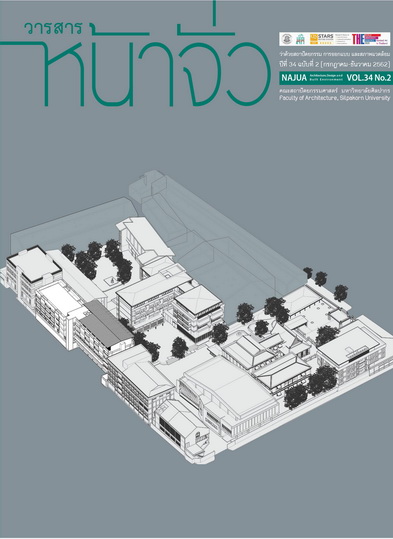Expanding Boundaries of Practice in (World) Heritage Management: from Conservation to Sustainable Development
Keywords:
World Heritage, boundaries of practice, heritage management, sustainable developmentAbstract
The adoption of the 2030 Agenda for Sustainable Development marks for the first time the inclusion of cultural heritage in the global development agenda. At the same time, it also raises a question about the readiness of existing heritage institutions to cope with this vastly expanded scope, in comparison to traditional mandates focused mainly on conservation. This paper proposes that the expanding boundaries of heritage practice has three important dimensions: changes in heritage concepts, changes in heritage management issues, as well as changes in managerial or governance frameworks. It traces key milestones in modern heritage practice since the mid-20th century, and offers policy recommendations for existing heritage institutions to deal with these new frontiers of management practice.
References
- Araoz, G. (2011). Preserving heritage places under a new paradigm.
- Bandarin, F., & Van Oers, R. (2012). The historic urban landscape: Managing heritage in an urban century. Chichester: Blackwell.
- Boccardi, G., & Scott, L. (2018). “A view from the inside: an account of the process leading to the adoption of the policy for the integration of a sustainable development perspective within the World Heritage Convention”. In W. Logan & P. Larsen (Eds.), World Heritage and Sustainable Development: New Directions in World Heritage Management. London: Routledge.
- Cannon, T. (2015). Paper presented at the Regional Conference on Harmonizing Actions to Reduce Risks for Cultural Heritage in Asia-Pacific, Penang, Malaysia.
- Cassar, M. (2005). Climate Change and the Historic Environment. London: University College London, Centre for Sustainable Heritage.
- Cassar, M. (2007). “Engineering Historic Futures”. In C. L. e. a. Walsh (Ed.), Building knowledge for a changing climate : collaborative research to understand and adapt to the impacts of climate change on infrastructure, the built environment and utilities. Newcastle: New castle University.
- Hosagrahar, J., Soule, J., Girard, L. F., & Potts, A. (2016). Cultural Heritage, the UN Sustainable Development Goals, and the New Urban Agenda. Retrieved from www.usicomos.org/wp-content/uploads/2016/05/FinalConcept-Note.pdf
- Venice Charter for the Conservation and Restoration of Monuments and Sites (1964).
- ICOMOS. (2017). Heritage at Risk: World Report 2014-2015 on Monuments and Sites in Danger. Retrieved from Berlin
- Intergovernmental Panel on Climate Change. (2007). “Contribution of Working Group I”. In S. Solomon, D. Qin, M. Manning, Chen, Z, , Marquis, Z, , K. B. Avery, M. Tignor, & H. L. Miller (Eds.), Fourth Assessment Report of the Intergovernmental Panel on Climate Change. Cambridge: Cambridge University Press.
- Jokilehto, J. (1999). A History of Architectural Conservation. Oxford: Butterworth-Heinemann.
- Logan, W. (2012). “States, governance and the politics of culture: World Heritage in Asia”. In P. Daly & T. Winter (Eds.), Routledge Handbook of Heritage in Asia. London: Routledge.
- Logan, W., & Larsen, P. (2018). “Policy-making at the World Heritage-sustainable development interface”. . In W. Logan & P. Larsen (Eds.), World Heritage and Sustainable Development: New Directions in World Heritage Management. London: Routledge.
- Mason, R., Maclean, M., & de la Torre, M. (2003). Hadrian’s Wall World Heritage Site. Retrieved from Los Angeles
- Ndoro, W. (2005). The Preservation of Great Zimbabwe: Your Monument, Our Shrine. Rome: ICCROM.
- Pahl-Wostl, C., Becker, G., Knieper, C., & Sendzimir, J. (2013). “How multilevel societal learning processes facilitate transformative change: a comparative case study analysis on flood management”. in Ecology and Society, 18(4), 58.
- Pereira Roders, A. (2013). How can urbanization be sustainable? a reflection on the role of city resource in global sustainable development: Bollettino Del Centro Calza Bini.
- Reed, J., Van Vianen, J., Deakin, E. L., Barlow, J., & Sunderland, T. (2016). “Integrated landscape approaches to managing social and environmental issues in the tropics: learning from the past to guide the future”. in Global Change Biology. Retrieved from https://doi.org/10.1111/gcb.13284
- Rossler, M. (2000). “Landscape Stewardship: New Directions in Conservation of Nature and Culture”. in The George Wright Forum, 17(1), 27-34.
- Roy, A. (2005). “Urban informality: toward an epistemology of planning”. in Journal of the American Planning Association, 71(2), 147-158.
- Sabbioni, C., Cassar, M., & Brimblecombe, P. (2006). “Noahs Ark: Global climate change impact on built heritage and cultural landscapes”. In R. Fort, M. Alvarez de Buergo, M. Gomez-Heras, & C. Vazquez-Calvo (Eds.), Heritage Weathering and Conservation. London: Taylor Francis Group.
- Schmitt, T. “Global Cultural Governance: Decision making about World Heritage between politics and sciences”. in Erdkunde, 63, 103-121. doi:10.3112/ erdkunde.2009.02.01
- Smith, L. (2006). Uses of Heritage. London: Routledge.
- Soini, K., & Birkeland, I. (2014). “Exploring the scientific discourse on cultural sustainability”. in Geoforum, 51, 213-223. doi:10.1016/j.geoforum.2013.12.001
- Thompson, J., & Wijesuriya, G. (2018). “From ‘Sustaining heritage’ to ‘Heritage sustaining broader societal wellbeing and benefits’: an ICCROM perspective”. In W. Logan & P. Larsen (Eds.), World Heritage and Sustainable Development: New Directions in World Heritage Management. London: Routledge.
- UN Task Team on the post-2015 UN Development Agenda. (2012). Realizing the Future We Want for All (Report to the Secretary General) Retrieved from www.un.org/millenniumgoals/pdf/Post_2015_UNTTreport.pdf
- UNESCO. (2011). Recommendation on the Historic Urban Landscape. Paris: UNESCO.
- UNESCO. (2012). Understanding World Heritage in Asia and the Pacific. Retrieved from Paris:
- UNESCO. (2018). Culture for the 2030 Agenda. Paris: UNESCO.
- Van Oers, R., & Pereira Roders, A. (2014). “Aligning agendas for sustainable development in the post 2015 world”. in Journal of Cultural Heritage Management and Sustainable Development, 4(2), 122-132.
- Winter, T. (2014). “Heritage conservation futures in an age of shifting global power”. in Journal of Social Archaeology, 14(3), 319-339.




